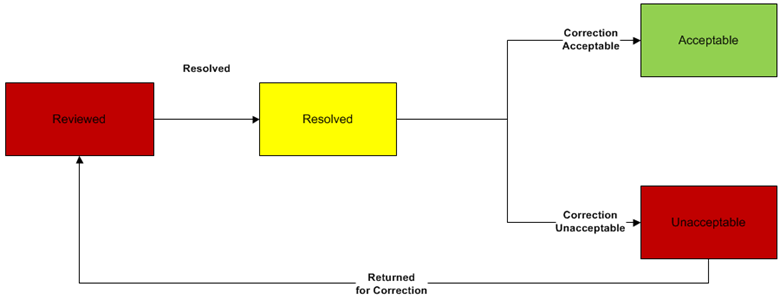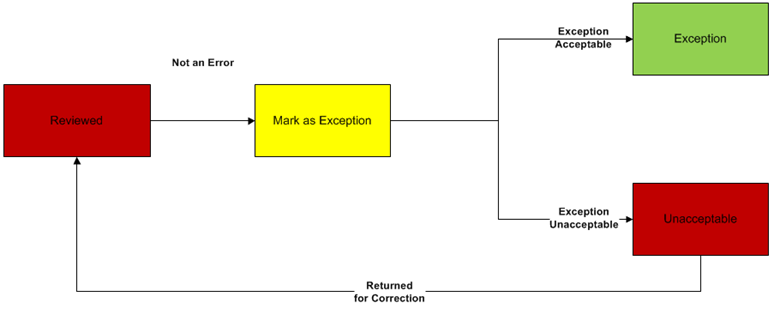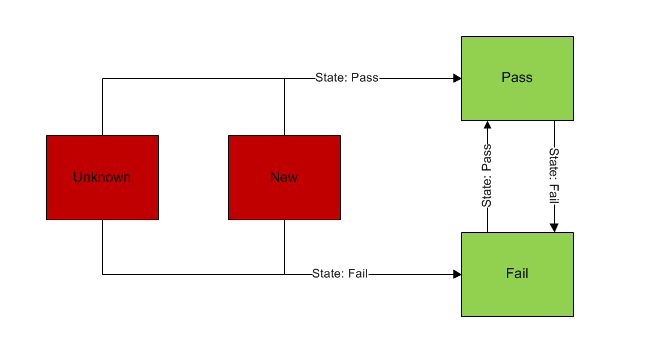Overview
When a feature or row is submitted to the Reviewer workspace, it becomes a Reviewer result. Data Reviewer assigns a life cycle status value that describes the result's state within the Reviewer quality control workflow. There are three phases in a resultí's life cycle:
- Review
- Correction
- Verification

Ideally, a result moves through each phase. Each of the phases can have different life cycle status values that describe how the result was handled. For example: A result in the Correction phase could have a life cycle status of Resolved or Mark As Exception.
Life Cycle status is progressive. As a result moves from Review to Correction to Verification, information related to when and who made the correction or verification is updated. Using the previous example, the result in the Correction phase with a life cycle status of Resolved or Mark As Exception would have Review notes set by the tool that submitted it. That same result would have empty Verification notes as it has not been verified yet.
Life Cycle status helps you understand how many results need to be fixed and verified. Once verified, you'll know how many results have been addressed.
Review
A result's initial phase is Review. A result's Review notes value is whatever was written by the tool that submitted it. For sampling results, the life cycle status will be New instead of Reviewed. The life ycle status values for a Review phase include the following:
- Reviewed
- New
- Unknown
- Unacceptable
A result can have a life cycle status of Unacceptable only when it had been moved through the Data Reviewer quality control workflow and reassigned to the Review phase.
The following tools and operations can submit a result to a Reviewer workspace and will have one of the above life cycle status values:
- Commit to Reviewer Table (Data Reviewer toolbar in ArcGIS for Desktop)
- Execute Batch Job (Geoprocessing tool)
- executeJob (Data Reviewer Server REST operation)
- Flag Missing Feature (Data Reviewer toolbar in ArcGIS for Desktop)
- Individual checks (Data Reviewer toolbar in ArcGIS for Desktop)
- Notepad tools (Data Reviewer table in ArcGIS for Desktop)
- scheduleNewJob (Data Reviewer Server REST operation)
- writeFeatureAsResult (Data Reviewer Server REST operation)
- writeResult (Data Reviewer Server REST operation)
- Write to Reviewer Table (Geoprocessing tool)
A result in the Review phase means that it needs to be corrected.
Correction
The next phase in a Reviewer result's life cycle is Correction. In this phase, the result submitted by one of the methods above is addressed. This usually involves a change to feature geometry or attribution. A Life Cycle status is applied to the result along with correction notes. The life cycle status for a correction phase includes the following values:
- Resolved
- Mark As Exception
A result in the Correction phase will be marked with a life cycle status of Resolved or Mark as Exception. It will contain information about the correction technician, correction date, and optional notes. Tools and operations that can change a result's life cycle phase to Correction include the following:
- Enter Correction Status(Data Reviewer table in ArcGIS for Desktop)
- updateLifecycleStatus (Data Reviewer Server REST operation)
Once a result is in Correction phase, it needs to be verified.
Verification
The last phase in a Reviewer result's life cycle is Verification. In this phase, the fix to the result is verified. A Life Cycle status is applied to the result along with optional verification notes. Life Cycle status to verify a result includes the following values:
- Acceptable
- Exception
- Unacceptable
A result in the Verification phase will be marked with a life cycle status of Acceptable or Exception. If a life cycle status is marked as Unacceptable, the result automatically moves to the Review phase. Tools and operations that can change a result's life cycle status to verification phase include the following:
- Enter Verification Status (Data Reviewer table in ArcGIS for Desktop)
- updateLifecycleStatus (Data Reviewer Server REST operation)
A result in the Verification phase with a life cycle status of Acceptable or Exception means that it has completed the Data Reviewer quality control workflow. The result identified by the quality control workflow has been reviewed, corrected, and verified.
Result Life Cycle Workflows
Feature/Metadata Result
Feature and Metadata results will move from Review to Correction to Verification phases.


Sampling Result
Sampling results use similar description codes and strings but do not move from Review to Correction to Verification phases. Instead, they move from Review to Verification phase directly. Similarly, when a Sampling result is written to a Reviewer workspace, it is in the Review phase represented by a life cycle status description string of New. A Sampling result presently in the Review phase will move to the Verification phase with possible life cycle status values of Pass or Fail.

Life Cycle Status Values
Life Cycle status has a description string that corresponds to a description code that will be in one of the Review, Correction, or Verification phases. The following table maps different life cycle status description codes and strings to different life cycle phases.
| Description Code | Description String | Lifecycle Phase |
|---|---|---|
| 0 | Unknown | Review |
| 1 | Reviewed | Review |
| 2 | Resolved | Correction |
| 3 | Mark As Exception | Correction |
| 4 | Acceptable | Verification |
| 6 | Unacceptable | Review |
| 9 | Exception | Verification |
| 10 | New | Review |
| 11 | Passed | Verification |
| 12 | Failed | Verification |
Unknown
If a result's life cycle state is Unknown, it is considered to be in the Review phase and can be moved through the workflow of Correction and Verification phases similar to a result with a life cycle status of Reviewed.